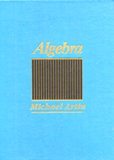
MATH W4041:
Intro to Modern Algebra I
Spring 2010

Read Chapter 6 of Artin, through Section 8. (Some of this material will be review for us; we have been working with permutations, and generators and relations, throughout the semester.)
| Sylow Practice (up to order 400) |
| Sylow Practice 2 (up to order 1000) |
The first document lists all products of two prime powers, up to order 400, with exponents 1 or 2. The number in parentheses is the number of groups of that order, up to isomorphism. For the two primes p that divide each order, the candidate numbers of conjugate p-Sylow subgroups are given, as determined by the Sylow theorems.
The second document lists only cases where there are more than two groups, up to order 1000.
Your goal is to reproduce these initial calculations for any of these orders, then construct the given number of nonisomorphic groups, through further analysis. The difficulty increases with the number of possible groups, and you aren't expected to be able to analyze all of these cases. Studying the trickiest cases will feel a bit like research.
Unlike last year's list, my program hasn't screened this list to remove the more difficult cases. Sometimes, even when there are only a few possible groups, the analysis can get quite tricky. This happens, for example, whenever one has to consider the automorphism group of a product of two cyclic groups of order p. There is only one nonabelian group of order 75, for example, but constructing it, and proving that there is only one, involves applying the Sylow theorems to the 480 = 2^5 * 3 * 5 invertible 2 x 2 matrices mod 5.
I returned Exam 2 in class on Tuesday. The distributions for exams 1 and 2, and total so far, are given in this file:
Exam DistributionsIf you can find your scores on these tables, and don't bomb the final, you will receive at least a C for the course, satisfactory for completing a math major. (Students in danger of actually flunking appear to have made other arrangements.) Past final grades for this course have typically consisted of 50% to 70% A- or higher, and up to 90% B- or higher. I however will grade based on actual performance. If I am convinced that many students have worked unusually hard, with performances to match, then I will give as many A's as I feel is warranted.
In particular, a surge on the final always impresses me.